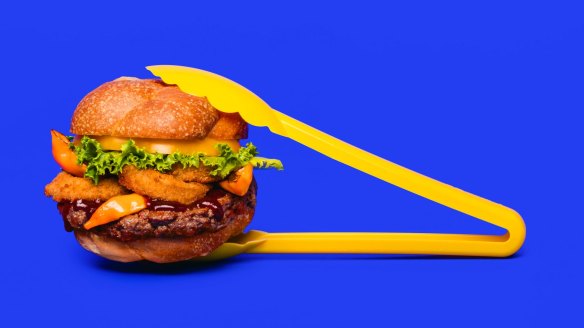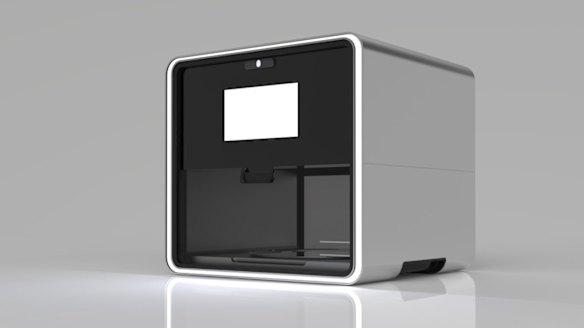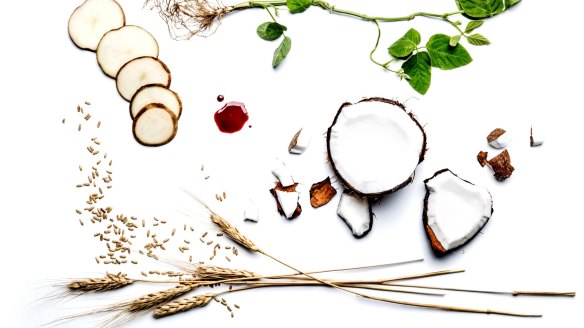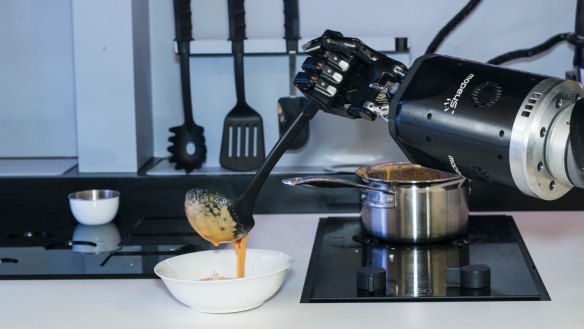Robots, 3D printing, bleeding vegan meats: food of the future is already here

- The future of food: Sex drinks, plant burgers and healthy cocktails
- Public craves healthy vending machines
There's no denying it: we've entered an age where our world is changing at a speed faster than ever before. The forecast for 2028 is mind-boggling: camera-equipped contact lenses, thought-controlled wearable tech, disease-detecting breathalysers on our smartphones.
No matter how advanced we become, humans have still got to eat, and a diet of soylent hardly whets the appetite. Strap in as we turn our future goggles towards food and the most delicious advancements coming your way.

3D printing revolutionises food waste
Spanish company Natural Machines predicts its Foodini 3D food printer will become as common as home microwaves within the decade.
Currently pitched to the Michelin star restaurant market, for $US4000 ($5400), the machine takes raw or prepared ingredients via capsules and prints them in different forms.

While the results – crisp garnishes in fancy patterns, pizza dough printed into a pizza base – haven't made a strong case for home cooks to take up the technology, the company sees home cooks making their own crackers, pretzels and pasta.
But Dr Angeline Achariya, CEO of the Food Innovation Centre at Monash University, sees beyond home-made Jatz, and believes the technology will answer a range of social problems. The only barrier? Our willingness to take it up.
In Australia, farmers are forced to trash up to 40 per cent of crops as supermarkets have incredibly specific standards for products, as revealed by Craig Reucassel's War on Waste documentary. Machines like the Foodini could step in and solve this, Achariya explains.

"Look at how much food we waste, the products that supermarkets reject because they're not perfect enough," Achariya says.
"So you could actually take those bananas and add an emulsifier or binder, just like so many other products have, and turn it into a sellable product. Or re-use home leftovers."
Think of 3D printers like piping bags on steroids, with pipes hot enough to melt chocolate or cook pastry, utilising three dimensional blueprints to build the food into layers and shapes. So hypothetically, a mushy banana, with a binding agent added, could be printed into banana cookies or snack bars.
"Worldwide, we have to look at how we will be able to feed nine billion people soon," Achariya says. "There are parts of the world that can't eat, and then parts that waste up to 40 per cent of their food. The technology to change that is here, and households can have a huge impact around how they manage waste."
The Meat and Lifestyle Association is also looking into 3D printing as a way to reduce waste, retexturising offcuts into more appealing products that go beyond sausages and burger patties. Building the food into thin layers results in a softer texture, eliminating toughness, connective tissue or gristle, but retaining nutrients and flavour.
Sufferers of dysphagia, a swallowing disorder which affects 8 per cent of the population, who are often advised to avoid any food that isn't of a soft texture, and the elderly may also benefit.
"It's great for institutions. Many people lose the ability to chew properly as they age or get dentures, and they are forced to go back to purees and soft foods, like what we ate as babies," Achariya says.
"Imagine 3D printing carrot so that it still looks like a carrot, but when you bite into it, it's softer. It gives people dignity, and I certainly don't want to eat baby food as I age."
Beyond quorn: Vegan meat coming to a store near you
Anyone with an interest in food will be familiar with the environmental problems posed by beef. Enter the Impossible Burger; a vegan patty that recreates beef in the most mind-blowing way, down to the sizzling pan juices and burger-like bite.
Since debuting in July 2016, it's become a daily fixture on the menu of rock star chef David Chang's Momofuku Nishi – and if you live nearby in Manhattan, you can even get it delivered to your house. Chang, a converted sceptic, charges $US15 ($20) a burger.
The patty is predominantly wheat protein, with coconut oil to mimic the sizzle of beef fat hitting the grill, and a game-changing ingredient "heme", found in hemoglobin (the red protein in red blood cells) and plants. In this case, heme is a soy-derived protein, fermented via traditional beer methods, lending the patty a beef-like juiciness that will have you reaching for a napkin.
Impossible Foods, backed by investors including Bill Gates and Google, plans to roll the burger out internationally "in the coming years", target the grocery market and develop more products. The first large-scale production facility launched in March this year (making 453 tonnes of vegan meat a month) and 10 additional American restaurants offer the burger, including Andrea's in Las Vegas, where you can order it as ma po tofu-style meatballs, or in delicate Thai crispy rice cups.
But why should Aussie carnivores care? The burger "uses about 75 per cent less water, generates about 87 per cent fewer greenhouse gases and requires around 95 per cent less land than conventional ground beef from cows," according to Impossible Foods, who have worked on the burger since 2011.
It's cholesterol-free, and packs 19 grams of protein a serve (a McDonald's hamburger has 13.4 grams), and as domestic beef prices continue to rise, it may become the most economical way to enjoy a beef-hit in the future.
At the opening of the production facility in March, Impossible Foods CEO Patrick O. Brown made no attempt to hide the company's ambitions.
"Our mission to transform the global food system is urgent, and the opportunity is huge, so we are embarking on one of the most ambitious scale-ups of any start-up in the food industry," he said.
"Our goal is to make delicious, sustainable, nutritious and affordable meat for everyone, as soon as possible."
Scan more than barcodes
Last month, leading futurist Craig Rispin terrified a room of food professionals at Food Industry Foresight's Future of Foodservice in Sydney seminar with the following anecdote about his visit to the Sydney Fish Market.
"I said to a fishmonger, 'What will happen when a customer can point a device at that fish and know what level of mercury is in it?" Rispon recounted. "He said to me, 'that will never happen."
Spoiler alert: it already has. The SCiO molecular scanner is available right now, for $US300 ($405), and takes up the same amount of space as a garage door clicker.
Aside from terrorising fishmongers, the handy device can read the calories in your ice cream cone, reveal the macro-nutrient breakdown of a protein shake, and assist with grocery shopping. Take pineapples or cling-film wrapped watermelon, for example; instead of pushing your nose up to smell it, a click of SCiO will analyse the fruit and tell you which one is the sweetest. It also has practical applications for identifying pharmaceuticals, but for the health-conscious, it will unlock a whole new side of dieting, offering more insights than your FitBit ever could.
Combine this technology with the existing technology of Samsung's Wi-Fi-enabled smart-fridge, and the booming industry of meal-kit services such as HelloFresh and America's behemoth Blue Apron, and the way we view daily dinner may change forever.
Achariya says that health advancements will inform our decisions more than ever as well.
"I think we'll see a new model of personalised nutrition where I might be able to do a genetic test on myself, and understand what I need to worry about, based on my lifestyle and genetic history, that I can use to create nutritionally-balanced special meals just for me," she says.
Robots for the home
That nutritionally-tailored meal, with molecularly-scanned food ordered by your smart-fridge isn't going to make itself. Enter Moley; a very human-like pair of robotic arms programmed to match the movements of a chef.
Moley Robotics Kitchen will launch to domestic customers in 2018, and is designed for a mass-market audience. By 2021, it will be available for $US35,000, which is "comparable to average sums spent on kitchen refurbishment."
The arms move ingredients into a pan to simmer, stir and serve up silky vermouth-laced crab bisque, or home-style spaghetti bolognese, with an "iTunes type platform" of recipes that will become open source for all users.
Thermomix fans, here's where the device differs to the all-in-one kitchen appliance; "The Moley Robotic Kitchen does not cook like a machine – it captures human skill in motion," the makers claim.
The human in question is British celebrity chef Tim Anderson, his movements mapped by an algorithm developed in part by Stanford University, that lets Moley mirror him completely. Expect even more as artificial intelligence tech catches up to robotics.
Robots out of the home
Even if you're not flush with cash, expect to interact with robots soon. Domino's Pizza has generated a slew of publicity for DRU (Domino's Robotic Unit), a little four-wheeled bot that could be cousin to Disney's Wall-E. He's capable of scaling footpaths, road and suburban terrain at 16 kilometres an hour with a cargo load of hot pizzas and cold drinks in temperature-specific compartments.
DRU officially launched to the public in Germany on May 10, while New Zealand experienced its first drone pizza delivery (zipping high above traffic jams and red lights) last November.
Between DRU, drones, and Uber's continued investment in driverless car technology, the bulging calves of food delivery app cyclists will become an endangered species.
Bartender's biceps are also in the firing line: robot bartenders have been shaking up custom drinks on Royal Caribbean cruise ships since 2014.
Makr Shakr is an Italian company, with two bionic-arm robots to each unit – named Mix and Mingle – with an ordering tablet for customers to make their own creation from 30 spirits, 21 mixers and the option to muddle, stir, shake and strain.
Restaurant consultant Jerry Prendergast estimates that it takes an experienced bartender one minute to make a classic cocktail (or 60 an hour) and four minutes to make a speciality one (10 an hour). These robots can create 120 customised drinks an hour, and when they aren't shaking, they are programmed to dance.
Still, they'll never have the swagger of Tom Cruise's bartending moves, and they most certainly won't chat you up.